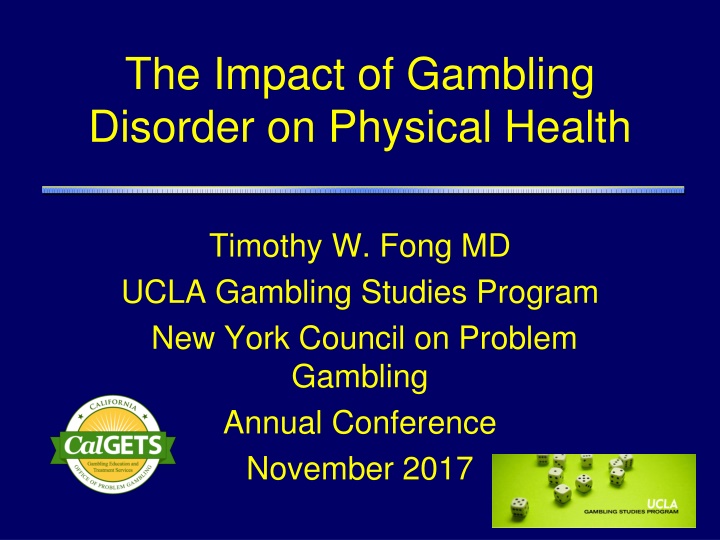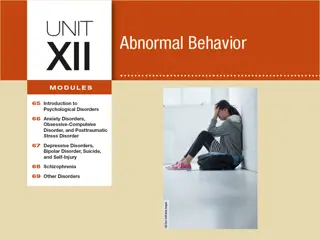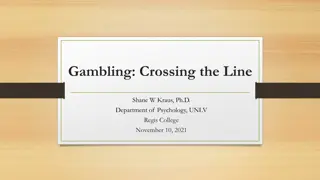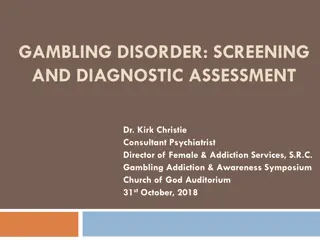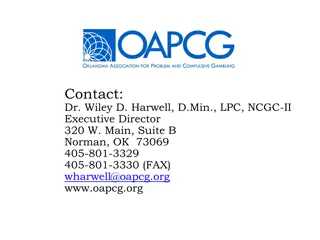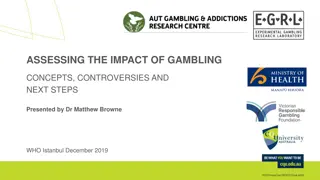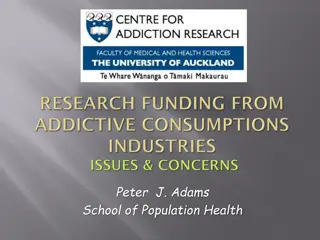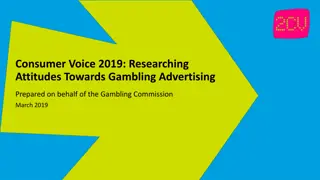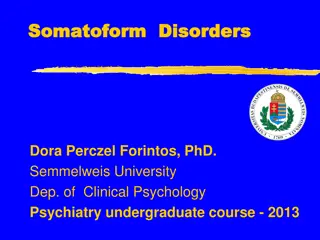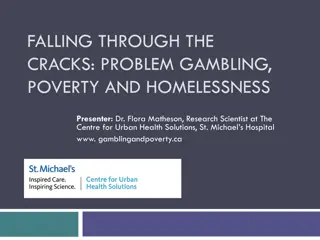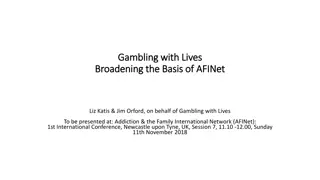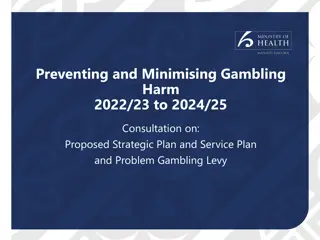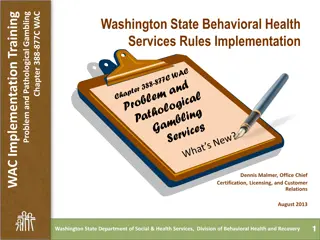Impact of Gambling Disorder on Physical Health: Overview and Strategies
Understanding the impact of gambling disorder on physical health, the presentation by Dr. Timothy W. Fong at the New York Council on Problem Gambling Annual Conference in November 2017 highlighted the importance of office-based strategies. The session covered the traditional and modern definitions of health, components of physical health, and data on physical activity, nutrition, obesity, and alcohol use, emphasizing the need for awareness and intervention to address these issues.
Download Presentation

Please find below an Image/Link to download the presentation.
The content on the website is provided AS IS for your information and personal use only. It may not be sold, licensed, or shared on other websites without obtaining consent from the author.If you encounter any issues during the download, it is possible that the publisher has removed the file from their server.
You are allowed to download the files provided on this website for personal or commercial use, subject to the condition that they are used lawfully. All files are the property of their respective owners.
The content on the website is provided AS IS for your information and personal use only. It may not be sold, licensed, or shared on other websites without obtaining consent from the author.
E N D
Presentation Transcript
The Impact of Gambling Disorder on Physical Health Timothy W. Fong MD UCLA Gambling Studies Program New York Council on Problem Gambling Annual Conference November 2017
Financial Disclosures Speaker Bureau Indivior Research Support Onward Constellation Health Connections in Recovery
Overview Physical health overview Gambling s impact on physical health Office-based strategies
Definitions of Health Traditional definition of physical health A person who is not stricken with a serious illness Modern definition: World Health Organization Health is a state of complete physical, mental and social well-being and not merely the absence of disease or infirmity
Components of Physical Health
Components of Physical Health Physical activity includes strength, flexibility, and endurance Nutrition and diet includes nutrient intake, fluid intake, and healthy digestion Alcohol and drugs includes the abstinence from or reduced consumption of these substances Medical self-care includes addressing minor ailments or injuries and seeking emergency care as necessary Rest and sleep includes periodic rest and relaxation, along with high quality sleep
Physical Activity DATA 2010 (US Census) 36% adults aged 18 years and older reported engaging in regular vigorous physical activity in 2005. 23% percent of adults aged 18 years and older reported having no leisure-time physical activity in 2006.
Nutrition, Diet, Obesity Obesity = Body Mass Index > 30 DATA 2010 for California adults aged 20 years and older 23.6% of Californians are obese.
Alcohol Use Binge drinking prevalence rates among California s adult population 18 years and older 15.4% in 2001 17.6% in 2005 13.3% in 2008 15.6% in 2015 AUD national prevalence: ~14%
Tobacco Use DATA 2010 show that California s adult cigarette smoking prevalence rates declined significantly from: 16.9 percent in 2000 14.5 percent in 2004 14.6 percent in 2006 13.8 percent in 2010
DSM-5 and SUD: 10 Drug Classes Alcohol Caffeine Cannabis Hallucinogens Tobacco Inhalants Opioids Sedatives, Hypnotics, Anxiolytics Stimulants Others
Medical Self-Care 28.1 million Californians under age 65 (85.4 percent) had some kind of health insurance coverage in 2007 87.8 percent of Californians had a usual source of ongoing care in 2005
Rest and Sleep According to data from the National Health Interview Survey, ~30% of adults reported an average of 6 hours of sleep per day In 2014, 31% of high school students reported getting at least 8 hours of sleep on an average school night.
Rest and sleep Rest is stressful I d rather be at work then on vacation You can rest when you are dead Snooze you lose Early bird catches the worm Family time matters most
Gambling Disorder and Physical Health
Gambling Disorder and Health (Pre-2000) Published reports showing association of gambling disorder with poorer overall health Not enough to impact policies, legislation or practice (Petry, Volberg, National Commission)
Health Problems and Medical Utilization Associated with Gambling Disorder Gambling severity associated with higher rates of medical utilization GD more likely than low-risk individuals to have been treated in the emergency room in the year Psychosom Med. 2006 Nov-Dec;68(6):976-84.
Gambling and Health: Primary Care Setting 574 adults presenting to an urban primary care medical clinic 10.6% pathological gambling 5.1% were classified as problem gamblers. Any GD reported more health-related concerns on indices of physical functioning. Recreational gambling was not associated with better health. BJ Morasco, KA vom Eigen, NM Petry - General hospital psychiatry, 2006
PG increases CV Disease Review of NESARC Data Focus on older adults (55+) PG status was associated with elevated odds for incident arteriosclerosis and heart conditions. Increased risk beyond established risk factors J Addict Med. 2013 ; 7(6):
PG Relation to Obesity, Medical Conditions, Lifestyle Random survey of 95 PG vs. 91 controls PG had more medical and mental health conditions than controls More likely to avoid regular exercise, smoke 1 pack/day, drink 5 servings of caffeine daily, and television 20hours/week. Compr Psychiatry. 2013 Feb;54(2):97-104
PG Relation to Obesity, Medical Conditions, Lifestyle Pathological gamblers reported impaired physical and emotional role functioning, but also bodily pain, impaired social functioning, and low vitality. Compr Psychiatry. 2013 Feb;54(2):97-104
California Gambling Education and Treatment Services (CALGETS) problemgambling.ca.gov
Health and Wellness 15-16 Medical problems The most common co-occurring health conditions of CalGETS clients are hypertension, diabetes, and obesity Access to Healthcare 70% of CalGETS client reported that they currently have a physician that they can access for primary care needs.
Health and Wellness 15-16 Alcohol Use CalGETS clients report a heavy drinking episode (more than five drinks in a single occasion) occurring, on average, every 20 days. Marijuana According NSDUH: 14.7% of the population of California self-reported using marijuana within the last 12 months. Across all treatment components, 16% - 45% of CalGETS clients use marijuana.
Health and Wellness 15-16 Smoking Among CalGETS outpatients, 31% currently smoke, three times the state average. In the residential treatment setting, the prevalence rate of smoking is 60%.
Health and Wellness 15-16 State of Health 30% of gamblers across all modalities reported their health as fair or poor Health Insurance 78% of all CalGETS clients reported having health insurance but less is known about how much their premiums, deductibles or costs are to maintain insurance.
Health and Wellness 15-16 Affected Individuals Health and Wellness profile mirrored that of the general population across all domains
UCLA Gambling Sleep Study - Results National Epidemiological Survey: (N=3412) PGs were almost 3.5 times more likely to experience a sleep problem compared to individuals who did not have a gambling problem Community Survey: (N=120) PGs experience significantly poorer sleep quality and increased daytime sleepiness relative to those that recreationally gamble.
UCLA Gambling Sleep Study Problematic Sleep Causes: impair self-control and decision-making increase impulsivity, attenuate responses to losses and increase expectations of gains degrade cognition in executive functioning tasks Become clinically aware whether client is also suffering sleep problems and include that in management
Understanding the link between gambling and physical health
Explaining this association Stress Model Increased physical and emotional stress leads directly to poor overall health Lack of exercise Gambling is sedentary Self-care neglect impulsivity / risk-taking / lack of interest
Explaining this association Lack of access to care Insurance, funds Genetics Shared risk factors Co-occurring SUD Primarily Tobacco and Alcohol
What about gambling promoting health?
Casino Openings and Childhood Weight Fitness testing of American Indians in California (tribes with casinos vs. tribes without a casino) Opening or expanding a casino was associated with increased economic resources and decreased risk of childhood overweight/obesity JAMA. 2014 Mar 5;311(9):929-36
Gambling, Health and Age NESARC Data Among older respondents, recreational gambling was associated not only with some negative measures (e.g., obesity) but also with some positive measures (e.g., better physical and mental functioning). Psychol Addict Behav. 2007 Dec;21(4):431-40.
Office Strategies to Improve Physical Health
Intake to CALGETS 43 yo female referred to CALGETS via online search Presents with 10 year history of gambling disorder (slots, online slots) Main damage -- $75K debt, diminished friends, low life satisfaction, personal development stalled Moderate depressive sxs
Health Overview Does not exercise (0) Does not smoke Drinks 10 standard drinks per week Has health insurance Works night shift, sleep not consistent and 3-5 hours blocks 5 2 ; 185lbs Diet Comfort eating; no idea
Physical Activity Exercise must be prescribed 3 times per week for 90 minutes 10,000 Steps per day Emerging use of Smartphone apps and digital trackers Take advantage of local fitness trends Partner with local trainer
Diet and Nutrition Start with Food Diary Develop local connections with cooking classes, private nutritionists and dietitians Weight loss goals = lb per week (approximately 1100 calorie difference)
Alcohol and Tobacco SBIRT practices Increase Smoking Cessation Toolbox 1-800-NO-BUTTS Focus on characterizing relationship between substances, gambling and health
Medical Care Identify primary care provider Overcome treatment barriers Become familiar with insurance options Learn healthcare milestones and encourage discussion Create healthcare goals
Rest and Sleep Sleep diaries Sleep hygiene practices Screen Time Caffeine Scheduled Naps Schedule Rest Periods Vacation time NOT family trips
The key to good health: Hot off the presses
Association Between Sauna Bathing and Fatal Cardiovascular and All-Cause Mortality Events Increased frequency of sauna bathing is associated with a reduced risk of SCD, CHD, CVD, and all-cause mortality. JAMA Intern Med. February 23, 2015.
Possible Trends Wearables Monitoring all aspects of health Real-time information / feedback Provider-client-linked incentives for health outcomes Bonus payments? Integrated care with community partners Recovery Prime Services
California Gambling Education and Treatment Services (CALGETS) problemgambling.ca.gov
